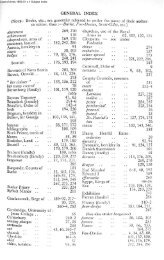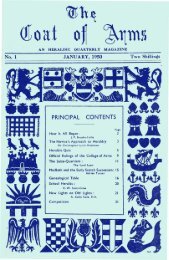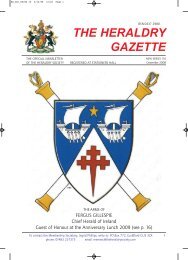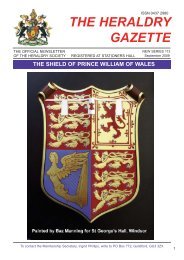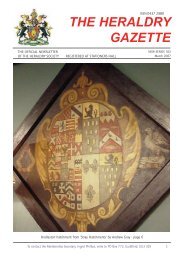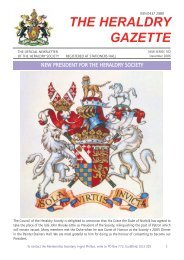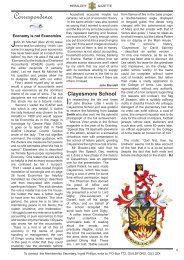You also want an ePaper? Increase the reach of your titles
YUMPU automatically turns print PDFs into web optimized ePapers that Google loves.
2<br />
CRANWELL HERALDRY<br />
PART ONE: THE ROYAL AIR FORCE BADGE<br />
Ceremonial Gates Cranwell Avenue Portico<br />
With the recent painting of the wrought-iron<br />
gates, and the re-gilding of the badges which<br />
adorn them, the Ceremonial Entrance to the<br />
Royal Air Force College has been restored to a<br />
state in which it would have been seen when<br />
College Hall was officially opened in 1934. By<br />
then the College had its own coat of arms but<br />
it was the badge of the Royal Air Force which<br />
was chosen for the gates, and the Cranwell<br />
version is made all the more impressive by the<br />
‘oversized’ eagle that flies out from the circlet<br />
and crown, which together complete the<br />
design.<br />
<strong>The</strong> Royal Air Force badge came into use in<br />
August 1918, when the circlet took the form of<br />
a garter and buckle. But in heraldry, this<br />
proved to be incorrect and it was replaced by a<br />
plain circlet when the badge was registered at<br />
the College of Arms on 26 January 1923.<br />
During the reigns of George V, Edward VIII<br />
and George VI the Tudor Crown had<br />
surmounted the circlet. But it seems that the<br />
crown, the circlet and the eagle were subject to<br />
a wide range of variations with regard to style,<br />
composition and proportion, and it was not until<br />
1949 that the design was standardised. From<br />
that date, the ‘oversized’ eagles, which<br />
dominate the badges on the gates of the<br />
College, gave way to a smaller version that<br />
dissects the circlet; in the form seen on the<br />
porticos, erected on Cranwell Avenue in 1997.<br />
<strong>The</strong> description of the Royal Air Force badge<br />
was promulgated in Air Ministry Orders<br />
A.666/49, which were published on 15<br />
<strong>Sep</strong>tember 1949, and it reads: “In front of a<br />
circle inscribed with the motto, ‘Per Ardua Ad<br />
Astra’, and ensigned with the Imperial Crown,<br />
an eagle volant and affronté, the head lowered<br />
and to the sinister”.<br />
By choosing the motto of the Royal Flying<br />
Corps and the emblem of the Royal Naval Air<br />
Service, it seems that the Air Council’s original<br />
intention was to demonstrate a clear lineage<br />
for the Royal Air Force; and yet these<br />
elements of the new badge have long given<br />
rise to conjecture and debate.<br />
<strong>The</strong> most persistent debate is to do with the<br />
emblem, which is supposed by some to be an<br />
albatross, because of its association with the<br />
Royal Naval Air Service. But it is precisely<br />
because of its association with the Royal<br />
Naval Air Service that the emblem is an eagle.<br />
In his book ‘Airmen or Noahs’, published by<br />
Pitman in 1928, Rear-Admiral Murray Sueter<br />
attributed the choice of the Royal Naval Air<br />
Service emblem to an item of jewellery owned<br />
by his wife. In a footnote he states, “Mr<br />
Winston Churchill wanted an eagle for a<br />
badge to be worn on the sleeve of the coat to<br />
distinguish the naval airmen. An artist was<br />
sent for and he produced a design like a<br />
goose. But Mrs Sueter had a gold eagle<br />
Items for inclusion in the Gazette post to: <strong>The</strong> Editor, <strong>The</strong> <strong>Heraldry</strong> Gazette, at the<br />
address given on page 10, or e-mail to: gazette@theheraldrysociety.com



